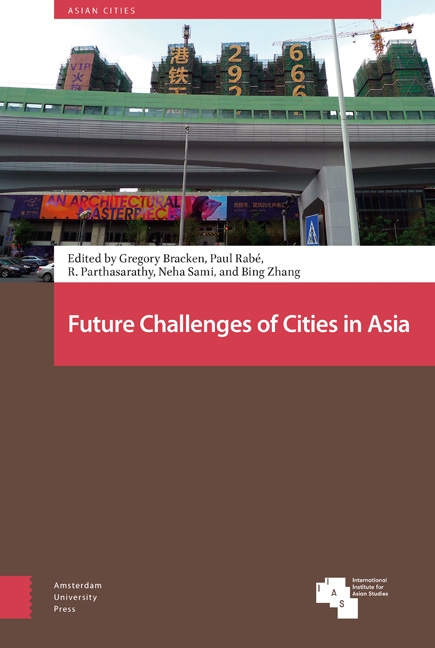Book contents
- Frontmatter
- About the Three UKNA Volumes
- Contents
- List of Figures and Tables
- 1 Future Challenges of Cities in Asia: An Introduction
- 2 Human Agency in the Asian City
- 3 Toward Inclusive, Vital and Livable City Scenarios: The Transformation of Urban Villages in Shenzhen
- 4 Cultural Dilemma in Beijing's Urban Regeneration: From Liulichang Cultural Street to Qianmen Street and Yangmeizhu Oblique Street
- 5 Housing as Heritage: The Great Urban Dilemma of the Global City of Shanghai
- 6 Not an Act of God: Lessons from a Disaster in the Settlements Planning of a River City
- 7 The Political Ecology of Climate Injustice in Bangkok
- 8 Assessing Flood-Related Vulnerability of the Urban Poor
- 9 The Ecological Future of Cities: Evaluating the Role of Green Infrastructure in Promoting Sustainability/Resilience in India
- 10 Hong Kong's “Rail-plus-Property” Development: A Model for Financing Public Transportation in Developing Cities in Southeast Asia?
- 11 Large Infrastructure Projects: The Emergence of Corridors in Asia
- Index
- Publications / Asian Cities
5 - Housing as Heritage: The Great Urban Dilemma of the Global City of Shanghai
Published online by Cambridge University Press: 21 November 2020
- Frontmatter
- About the Three UKNA Volumes
- Contents
- List of Figures and Tables
- 1 Future Challenges of Cities in Asia: An Introduction
- 2 Human Agency in the Asian City
- 3 Toward Inclusive, Vital and Livable City Scenarios: The Transformation of Urban Villages in Shenzhen
- 4 Cultural Dilemma in Beijing's Urban Regeneration: From Liulichang Cultural Street to Qianmen Street and Yangmeizhu Oblique Street
- 5 Housing as Heritage: The Great Urban Dilemma of the Global City of Shanghai
- 6 Not an Act of God: Lessons from a Disaster in the Settlements Planning of a River City
- 7 The Political Ecology of Climate Injustice in Bangkok
- 8 Assessing Flood-Related Vulnerability of the Urban Poor
- 9 The Ecological Future of Cities: Evaluating the Role of Green Infrastructure in Promoting Sustainability/Resilience in India
- 10 Hong Kong's “Rail-plus-Property” Development: A Model for Financing Public Transportation in Developing Cities in Southeast Asia?
- 11 Large Infrastructure Projects: The Emergence of Corridors in Asia
- Index
- Publications / Asian Cities
Summary
Abstract
Across China, the preservation and reconstruction of European-styled buildings for commercial purposes has become a trend for urban development. Drawing inspiration from established global cities, Shanghai’s local government has aimed to accommodate both modern high-rise and heritage buildings as a major part of its “city with global inspiration” urban development program. Historic preservation, however, has so far been about protecting particular structures from which only members of the urban middle class can benefit from their historic value. Then, for whom is this historic preservation? Presenting a less benign side of preservation, this chapter ethnographically examines social change in urban life as a result of urbanization, presenting how historic preservation affects urban processes vis-à-vis a sense of place in the city of Shanghai.
Keywords: Shanghai, social change, historic preservation, gentrification, urban space
Introduction
Across China, the preservation and reconstruction of European-styled buildings for commercial purposes has become a trend for urban development. This has been the case especially during the past two decades. After the quasi-colonial period of more than a century (1842-1945), a few of these buildings survived heavy usage during the high communist era (1949-1978) during which they were reoccupied by workers. During the first decade of the Reform and Opening-up (gaigekaifang) era that began in the early 1980s, these buildings continued to be heavily used. Drawing inspiration from urban planning in cities such as New York, London, and Tokyo, Shanghai's local government has since the early 2000s been building the city to accommodate both modern high-rise and heritage buildings. The local government of Shanghai sees city branding as a major part of its urban development program (see Development Research Center 2014). Integral to this emerging brand is the preservation of historic buildings – what major global cities commonly share (Ren 2008). In recent years, the authority's perceptions of these buildings have changed from being dilapidated remnants of colonialism to be replaced, to “historical artifacts” worthy of preservation to be protected as the city's cultural capital (Urban Land Institute 2014). Nevertheless, both preservation and reconstruction do not come cheap. While there are many sociocultural reasons to support government-led preservation of historic structures, a compromise is often necessary.
- Type
- Chapter
- Information
- Future Challenges of Cities in Asia , pp. 99 - 130Publisher: Amsterdam University PressPrint publication year: 2019



